| |
Page 1
IN THE UNITED STATES DISTRICT COURT
FOR THE DISTRICT OF COLUMBIA
IN THE UNITED STATES DISTRICT COURT
FOR THE DISTRICT OF COLUMBIA
UNITED STATES OF AMERICA,
Petitioner,
v.
MICROSOFT CORPORATION,
Respondent.
|
|
|
|
|
|
|
|
|
|
|
|
| |
Supplemental to
Civil Action No. 94-1564
Hon. Thomas Penfield Jackson
|
REPLY MEMORANDUM OF THE UNITED STATES IN SUPPORT
OF ITS MOTION FOR JUDGMENT OF CIVIL CONTEMPT AND
TO ENFORCE PRELIMINARY INJUNCTION
This Court's preliminary injunction prohibited Microsoft from conditioning a license to
Windows 95 on OEMs' licensing and preinstalling Microsoft's Internet browser software.
Seizing neither on the language of the Court's Order nor an analysis of its purpose, but rather
offer, as the sole alternative it need offer to its conditioned license, a version of Windows 95 that
will not work. Because the practical consequence is to require that OEMs license Microsoft's
browser, the injunction, as Microsoft implements it, serves only to entrench the very conditioning
the Court clearly declared must "abate[]" (Memorandum and Order ("Mem.") at 17).
Microsoft's position is untenable. Microsoft's refusal to focus on the language of the
injunction, or to read it "in light of the circumstances surrounding its entry," United States v.
Christie, 465 F.2d 1002, 1007 (3d Cir. 1972), has produced a "patently unreasonable," "twisted"
and "tortured construction" of the Court's Order that renders it "a nullity." United States v.
Greyhound Corp., 508 F.2d 529, 532-33 (7th Cir. 1974). Microsoft's offer of another "option" --
Page 2
an outdated, and therefore to OEMs commercially unviable, version of Windows 95 that
Microsoft nowhere contends comports with its reading of the injunction -- demonstrates
Microsoft's own discomfort with its position and reinforces the conclusion that the Court's Order
cannot reasonably be read as Microsoft construes it.
Microsoft's refusal to obey the Court's Order required a swift response. The United
States accordingly proposed a particular form of relief: that Microsoft make available to OEMs
the most recent version of Windows 95 from which Internet Explorer has been (or readily can by
OEMs be) "uninstalled" using Windows 95's "Add/Remove Programs" utility. This remedy, the
United States explained, would fully effectuate the purpose of the preliminary injunction;
namely, to ensure that Microsoft makes available to OEMs the most current version of Windows
95 (a commercial necessity for them) without also requiring OEMs to offer that which the market
regards as Internet Explorer.
Microsoft argues that this proposal threatens an unwarranted intrusion into software
design, but that is plainly incorrect. It is Microsoft that has chosen to respond to the Court's
Order by jerry-rigging its own products -- deleting files that otherwise need not be deleted. In
contrast, the relief proposed by the United States takes Microsoft's products as it has designed
them. The proposed remedy simply requires Microsoft to stop enforcing its licensing agreements
in a manner that prevents OEMs from obtaining the benefits of the uninstall capability that
Microsoft already includes in Windows 95 and makes available to end users. Although
Microsoft now claims that invoking this feature will "degrade" Windows 95 in some unspecified
way, this belated assertion is belied by Microsoft's own promotion of Internet Explorer.
Microsoft advertises: "IE uninstalls easily if you want . . . simply [to] get rid of it" (Gaspar Decl.
19 Ex. 9).
This Court has authority to enter the relief proposed by the United States. The purpose of
the Court's injunction was to prevent Microsoft, through its conditioned licenses, from
"reinforc[ing] its operating system monopoly" or "acquir[ing] yet another monopoly in the
Internet browser market" (Mem. at 17). Microsoft was free to implement any solution it saw fit
that avoided the forbidden conditioning; it failed to do so. The relief proposed by the United
States merely enforces rather than impermissibly expands the injunction and is necessitated by
Page 3
Microsoft's contumacious failure to comply with the Court's Order.
I. Microsoft Is Violating This Court's Order
Microsoft admits that its reading of the injunction yields a senseless result (Memorandum
in Opposition ("Op.") at 3). But rather than draw from this the obvious inference that its
construction of the injunction is incorrect Microsoft asserts that this Court entered a senseless
Order (id.). The fault, however, lies with Microsoft, not the Court. Examination of the
"language of the order and the objective circumstances surrounding [its] issuance," United States
v. Young, 107 F.3d 903, 907 (D.C. Cir. 1997), demonstrates that Microsoft is in clear violation of
both the injunction's "letter and spirit." Greyhound, 508 F.2d at 541; In re Arthur Treacher's
Franchise Litig., 689 F.2d 1150, 1157 (3d Cir. 1989); Grove Fresh Distribs., Inc. v. John Labatt
Ltd., 888 F. Supp. 1427, 1438 (N.D. Ill. 1995).
A. The Injunction Prohibits Microsoft From Effectively Conditioning A License
To A Commercially Viable Version Of Windows On An OEM's Licensing
Microsoft's Browser Software
The plain meaning of the preliminary injunction is this: Microsoft cannot require an
OEM, either as a matter of contract or practical economics, to take what in ordinary commercial
parlance is "Microsoft['s] browser software" -- specifically, software ordinary users employ for
Internet browsing -- as a condition of obtaining a commercially viable version of Windows 95.
At the same time, the injunction does not compel any particular mode of compliance with its
proscription as long as Microsoft avoids the forbidden conditioning. Save for this limitation, the
injunction, far from amounting to a sweeping "intrusion into product design" (Op. at 2) that
"dictate[s] on a file-by-file basis what features and functionality Microsoft can and cannot
include in Windows 95" (Op. at 4), leaves the composition of Microsoft's products to Microsoft.
This reading of the preliminary injunction is clearly contemplated by its plain language.
If, as a practical matter, OEMs cannot obtain a commercially viable version of Windows 95
except also by licensing and preinstalling software ordinary users invoke to obtain browser
functionality, then Microsoft plainly has "implied[ly]" "condition[ed]" a license to "Microsoft
Page 4
personal computer operating system software" on OEMs "also licens[ing] and preinstall[ing]"
"Microsoft Internet browser software" (Mem. at 19). On the other hand, if the mode of
compliance selected by Microsoft permits OEMs to license a commercially viable version of
Windows 95 without "also licens[ing] and preinstall[ing]" what in ordinary commercial parlance
is "Microsoft Internet browser software," then the forbidden "condition[ing]" is absent, and the
injunction is not violated.
This reading of the injunction is confirmed by "the circumstances surrounding [the
Order's] entry" including "the mischief the injunction seeks to prevent." Christie, 465 F.2d at
1007. The United States commenced this proceeding in order to restrain Microsoft from using its
Windows 95 monopoly to injure competition among browsers in violation of Section IV(E)(i) of
the consent decree. The government argued, and the Court tentatively accepted, that Internet
Explorer is a separate and not an "integrated" product within the meaning of Section IV(E)(i) in
large measure because such web-browsing software "enjoys substantial" "consumer demand"
"independent" from operating system software (Mem. at 12, 15, 16-17). Concluding that
Microsoft's licensing practices must "abat[e]" because they threaten "to reinforce [Microsoft's]
operating system monopoly" and to garner for Microsoft "yet another monopoly in the Internet
browser market," (Mem. 16-17), the Court entered the preliminary injunction.
The purpose of the injunction, in other words, is to ensure that market forces, and not
Microsoft's monopoly power, determine how OEMs satisfy the "independent consumer demand"
for browsers. This purpose would be thwarted if the injunction permitted Microsoft to offer a
commercially viable version of Windows 95 only to OEMs that also license the separate software
intended to satisfy "independent consumer demand" for browsers -- that which enables ordinary
users to invoke browser functionality. At the same time, the Court's objective can be met
without requiring from Microsoft a particular form of compliance. The purpose of the injunction
is not to determine the composition of Microsoft's products, but rather to prevent Microsoft from
achieving through its licenses the practical conditioning that threatens to protect and extend its
monopoly power. 1
Page 5
B. Microsoft's Construction Of The Injunction Is Misconceived And Amounts
To A Flouting Of The Court's Order
Microsoft does not seriously contest that, contrary to what the injunction demands, it has
failed to provide OEMs with a commercially viable alternative to its conditioned licenses. 2
Instead, Microsoft insists this straightforward reading of the injunction is "utterly unsustainable"
(Op. at 5). Despite the stridency with which it asserts that it is in full compliance with the
"letter" and "spirit" of the Court's Order (Op. at 7), Microsoft nowhere addresses either the
injunction's actual language or its purposes. The reason for these omissions is plain.
Microsoft's construction of the injunction, although it conveniently fits Microsoft's theory of
Section IV(E)(i), cannot be squared with elementary principles of interpretation.
Microsoft's entire argument proceeds from the assumption that "[t]he preliminary
injunction prevents Microsoft `from forcing OEMs to accept and preinstall the software code that
Microsoft itself now separately distributes at retail as "Internet Explorer 3.0"'" (Op. at 6.
(quoting Mem. at 15-16)). Although Microsoft represents that the quoted passage is the "explicit
language of the preliminary injunction" (Op. at 6), it is not. Rather, it is simply a passage from
the Court's Opinion that explains why the injunction will not cause Microsoft irreparable harm.
Microsoft appears to take this passage to define the phrase "any Internet browser
software" in the injunction (Op. at 10) and thus to supply the injunction's plain meaning.
Microsoft, however, has "confuse[d] `plain meaning' with literalism." Bell Atlantic Tel. Cos. v.
Page 6
FCC, 1997 WL 783993, at *1 (D.C. Cir. Dec. 23, 1997). The plain meaning of the injunction
cannot be the construction that "for all practical purposes" "renders" the Order "a nullity." E.g.,
United States v. Greyhound Corp., 508 F.2d 529, 533 (7th Cir. 1974); Grove Fresh Distribs.,
Inc. v. John Labatt Ltd., 888 F. Supp. 1427, 1438 (N.D. Ill. 1995); cf. United States v.
Granderson, 511 U.S. 39, 59 (1994) (Scalia, J., concurring) (statute cannot be read to produce a
"result" that is "utterly absurd"). Yet, that is precisely the result Microsoft's literal adherence to
the passage produces. Under Microsoft's reading of the injunction, it is entitled to offer as the
only alternative to its conditioned license a version of Windows 95 that simply will not work.
Because this effectively requires that OEMs continue to license Microsoft's browser software in
order to license Windows 95, Microsoft's construction plainly renders the injunction's
prohibition on conditioning the latter on the former a dead letter; it is, therefore, a "patently
unreasonable" reading. Greyhound, 508 F.2d at 533.
Not surprisingly, when the passage to which Microsoft points is read in light of "the
circumstances surrounding [the injunction's] entry" including "the relief sought by the moving
party, the evidence produced" in this proceeding and "the mischief that the injunction seeks to
prevent," Christie, 432 F.2d at 1007, it lends Microsoft no support. Microsoft explained to the
Court, well before the Court entered its Order, that Microsoft included in its retail version of
Internet Explorer 3 a small number of files that replaced and upgraded certain Windows 95 files
and that, as a result, requiring Microsoft to offer OEMs a version of Windows 95 without any of
those files would produce a version of Windows that would not work. See Cole Decl. 47, 51,
55, 78-80, 83-85, 92-93; Supp. Cole Decl. 2-4, 6-8. To argue, as Microsoft now does, that the
Court directed it to remove all the files Microsoft includes in its retail version of Internet
Explorer 3 is to presuppose that the Court completely ignored this submission. To the contrary,
the Court acknowledged this exact point two pages earlier in its opinion. See Mem. at 13-14.
Perhaps recognizing that it must find a justification for its position elsewhere than in the
Court's Memorandum and Order, Microsoft contends that it simply reads the preliminary
injunction to require the precise relief the United States requested. Even if it the Court simply
adopted the United States' position, the United States asked for no such thing. To be sure, the
United States did request an Order prohibiting "Microsoft from forcing OEMs to accept and
Page 7
preinstall the software code Microsoft separately distributes at retail as `Internet Explorer 3.0'"
(U.S. Reply Br. at 16). But Microsoft neglects to mention the government's careful qualification
-- that the United States did not mean to suggest that Microsoft should be required to offer a
version of Windows that did not work because it failed to include system files Microsoft also
happens to distribute in its retail version of Internet Explorer 3 (U.S. Reply Br. at 17). Indeed,
presaging the most reasonable reading of the sentence to which Microsoft points, the United
States explained that Microsoft offered no reason why it would need to withhold from OEMs
those system files Microsoft plainly would include in a functional version of Windows (see id.).
It is Microsoft, not the United States, "that is engaged in revisionist history" (Op. at 5).
Moreover, Microsoft's reading of the injunction is undermined by its own conduct. If, as
Microsoft contends, it were reasonable to construe the injunction to require that Microsoft make
available to OEMs only a nonfunctional version of Windows as an alternative to its present
conditioned license, Microsoft would have done nothing else. However, effectively conceding
that the injunction cannot reasonably be read to mean what Microsoft now says it means,
Microsoft also offered OEMs a second option: "the current retail version of Windows" "minus"
what Microsoft characterizes "as the Internet Explorer 3.0 update" (Op. at 6). As it turns out, this
option is as commercially worthless to OEMs as the first option and thus also fails to secure
compliance with this Court's injunction. 3 But the very fact Microsoft hedged its bets with this
option -- which Microsoft nowhere contends by itself satisfies the injunction -- demonstrates that
Microsoft's construction of the injunction is a contrivance, adopted not in order "to give effect to
its spirit and purpose," Grove Fresh, 888 F. Supp. at 1438, but rather to advance its own
interests.
Citizens confronted with court orders, whether or not they believe them lawful, have an
obligation to "obey [them] out of `respect for judicial process.'" GTE Sylvania, Inc. v.
Page 8
Consumers Union of the United States, 445 U.S. 375, 387 (1980) (quoting Walker v. City of
Birmingham, 388 U.S. 307, 321 (1967)). If Microsoft had genuine difficulty discerning its
obligations under the injunction, it "could have petitioned the District Court for a modification,
clarification or construction of the order." McComb v. Jacksonville Paper Co., 336 U.S. 187,
192 (1949). But Microsoft "did not take that course." Id. Nor did it so much as attempt a
reasonable interpretation of the injunction's language in light of its context. Rather, Microsoft,
"mak[ing] its own determination of what the [injunction] meant," id., contumaciously
implemented a "twisted construction" of the Order that reads it in effect to authorize the very
conduct the Court intended to enjoin. 4
II. The Relief Proposed By The United States Is Appropriate And Ensures Full
Compliance With The Injunction
In response to Microsoft's intransigence, the United States proposed a particular form of
compliance: that Microsoft be required to permit OEMs to license the latest version of Windows
95 from which Internet Explorer has been "uninstalled" using Windows 95's "Add/Remove
Programs" utility (Motion for Judgment of Contempt at 3-4). Such relief, the United States
explained, will give OEMs the choice of licensing Windows 95 without the attributes that meet
"independent consumer demand" for the browser -- the visible signs of, and easy user access to,
browser functionality -- without harming the underlying operating system (see id. at 4).
Microsoft complains that the relief proposed by the United States fails to ensure
compliance with this Court's Order and, in any event, will not achieve the result the United
States represents. Microsoft's first contention falls with its unreasonable reading of the
injunction. Microsoft objects that the proposed relief will not bring it into "compliance with the
Order" because "the great bulk of Internet Explorer 3.0 remains even after it has supposedly been
Page 9
uninstalled" (Op. at 9-10). But the injunction prohibits Microsoft, through its conditioned
licenses, from distorting competition among browsers. The remedy suggested by the United
States prevents the forbidden conditioning; Microsoft's response does not. 5
Microsoft's conduct not only is unfaithful to the purposes of the Court's Order, but also is
less than faithful to Microsoft's purported interest in preserving for itself the right to design its
products as it sees fit. Microsoft's construction of the Order requires it to redesign its own
products -- by deleting files and impairing functionality -- in a manner for which there is
otherwise no occasion. By contrast, the remedy proposed by the United States takes Microsoft's
products just as Microsoft has designed them. It is Microsoft that designed the "uninstall"
feature, that advertises it to the world on its web-site, and that uses it to induce computer users to
install Internet Explorer (telling them "IE uninstalls easily if you want . . . simply [to] get rid of
it" (Gaspar Decl. 19, Ex. 9)). And it is Microsoft that enables users to uninstall what it calls
"Internet Explorer" (not "some files from" Internet Explorer) in recognition of the commercial
significance of the files that are deleted by the "uninstall" procedure. 6 The United States simply
asks that OEMs be permitted to benefit from this very uninstall procedure that Microsoft has
already created. For precisely these reasons, Microsoft's further contention -- that the relief
proposed by the United States will degrade functionality users associate with the operating
Page 10
system (Op. 4, 9-10) -- is curious. Microsoft, as just explained, expressly represents to
consumers that "IE uninstalls easily if you want . . . simply [to] get rid of it" (Gaspar Decl. 19
Ex. 9), and continues to do so, see IE Challenge (Dec. 25, 1997)
(same); McCarthy Decl. 4 App. 3 (explaining how to
"uninstall Microsoft Internet Explorer" from OSR 2 by reinstalling it from another source and
then "uninstall[ing] [it by] using the Add/Remove Programs tools"), without warning them of any
"degradation" they might experience.
Because it simply makes available to OEMs alternatives that Microsoft's own conduct
shows it believes consumers will find desirable, the proposed remedy, far from "advanc[ing] no
conceivable goal of the antitrust laws" (Op. at 11), furthers antitrust objectives. The point, of
course, is not to hinder Microsoft's efforts to create improved products, but rather to prevent
Microsoft from using its Windows monopoly to place a thumb on the scale in browser
competition. As this Court noted, "[t]he probability that Microsoft will not only continue to
reinforce its operating system monopoly by its licensing practices, but might yet acquire another
monopoly in the Internet browser market, is simply too great to tolerate until [this case] is finally
resolved" (Mem. at 17).
III. This Court Has Jurisdiction To Enter The Proposed Order
Microsoft asserts that the relief proposed by the United States amounts to an improper
request to modify the injunction during the pendency of Microsoft's appeal (Op. 12-14). This
contention, premised as it is on Microsoft's incorrect reading of the injunction, is a "deft
semantic [mis]characterization." United States v. Microsoft, 56 F.3d 1448, 1456 (D.C. Cir.
1995). As explained, requiring Microsoft to make available to OEMs the benefits of its own
"uninstall" option simply brings Microsoft into compliance with, and thus enforces rather than
expands, the existing injunction. It is well-settled that "[a] district court" "after the notice of
appeal has been filed" "may take action to enforce its order in the absence of a stay." E.g., NLRB
v. Cincinnati Bronze, Inc., 829 F.2d 585, 588 (6th Cir. 1987) (upholding entry of subsequent,
more specific order that "enforced and clarified" an appealed but unstayed order) (citing Deering
Page 11
Milliken, Inc. v. FTC, 647 F.2d 1124, 1128-29 (D.C. Cir.) (Mem.), cert. denied, 493 U.S. 958
(1978)).
The ancillary relief proposed by the United States -- a prohibition on retaliation against
OEMs for invoking the "uninstall" option and a requirement that Microsoft notify the Court and
the United States, in advance of r
eleasing a product within the injunction's scope, of the nature of
the release and the steps Microsoft believes will ensure compliance with the injunction --
similarly is carefully calibrated merely to ensure that Microsoft complies with the preliminary
injunction and works no impermissible modification. See, e.g., Meinhold v. United States
Department of Defense, 34 F.2d 1469, 1480 n.14 (9th Cir. 1994) (explaining that a court retains
jurisdiction to "issue[ an] amended order to clarify its original injunction and to supervise
compliance in the wake of [a subsequent] motion for contempt"). In any event, Microsoft
concedes that "new fact[ual] develop[ments]" might warrant imposing on Microsoft additional
obligations in furtherance of the injunction (Op. at 14). The new fact that justifies ordering the
proposed relief is Microsoft's contumacious failure to comply with this Court's Order. "[I]n
enforcing its orders, the district court may adapt the form of the application of its power
according to the resistance to enforcement with which it is confronted." Madden v. Grain
Elevator, Flour and Feed Mill Workers, 334 F.2d 1014, 1020 (7th Cir. 1964), cert. denied, 379
U.S. 967 (1965).
It is Microsoft, not the United States, that improperly seeks to rewrite the Court's
injunction. The Court should end Microsoft's disobedience and bring it into compliance.
Dated: December 29, 1997 Respectfully submitted,
Joel I. Klein
Assistant Attorney General
A. Douglas Melamed
Principal Deputy Assistant Attorney
General
Page 12
Rebecca P. Dick
Director of Civil Non-Merger
Enforcement
Christopher S Crook
Chief
Phillip R. Malone
Steven C. Holtzman
Pauline T. Wan
Karma M. Giulianelli
Michael C. Wilson
Sandy L. Roth
John F. Cove., Jr.
Mark S. Popofsky
Attorneys
Antitrust Division
U.S. Department of Justice
Room 10-0101
450 Golden Gate Avenue
San Francisco, CA 94102
415/436-6660
.
Page 13
CERTIFICATE OF SERVICE
The undersigned certifies that on December 29, 1997, copies of the foregoing REPLY
MEMORANDUM OF THE UNITED STATES IN SUPPORT OF ITS MOTION FOR
JUDGMENT OF CIVIL CONTEMPT AND TO ENFORCE PERMANENT INJUNCTION were
served by facsimile transmission and Federal Express overnight delivery upon:
Special Master
Professor Lawrence Lessig
1525 Massachusetts Avenue
G-502
Cambridge, MA 02138
Counsel for Microsoft Corporation
William H. Neukom, Esq.
Microsoft Corporation
One Microsoft Way
Redmond, Washington 98052
Richard J. Urowsky, Esq.
Sullivan & Cromwell
125 Broad Street
New York, New York 10004
James R. Weiss, Esq.
Preston Gates Ellis & Rouvelas Meeds
1725 New York Avenue, NW
Washington, DC 20006
__________________________
Mark S. Popofsky
Attorney
Antitrust Division
|
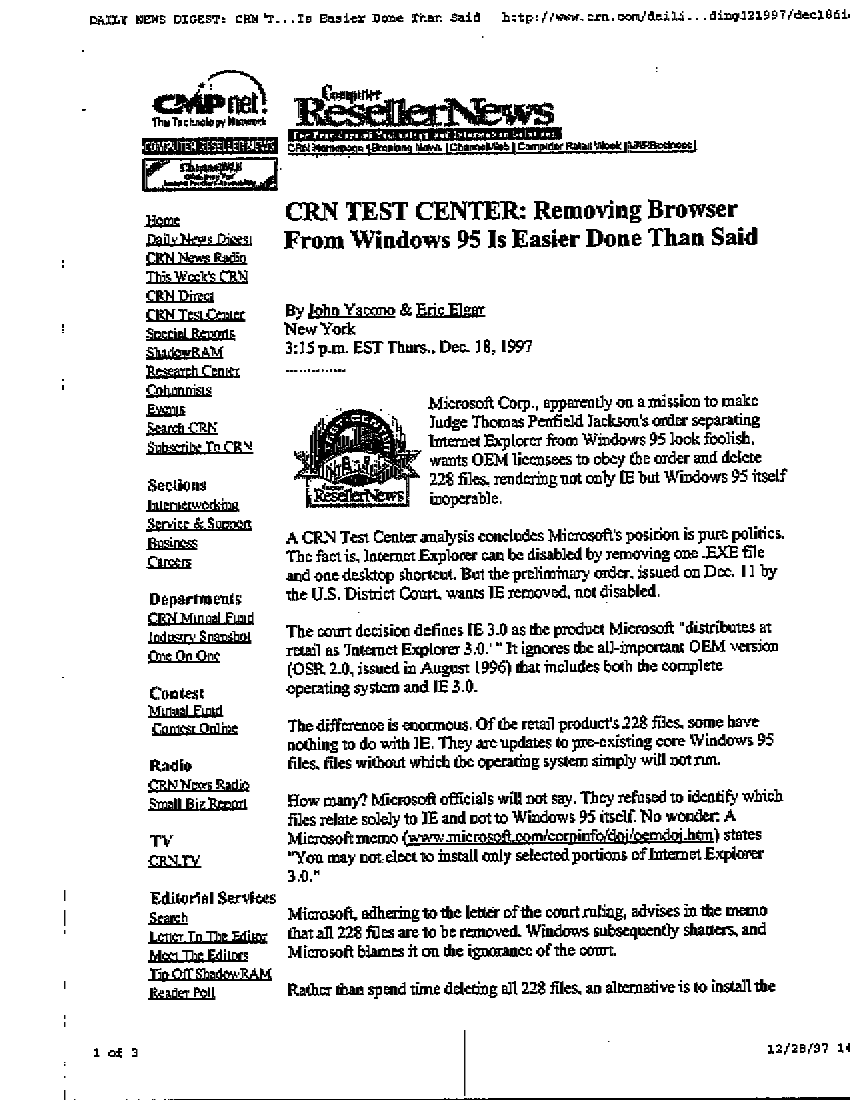
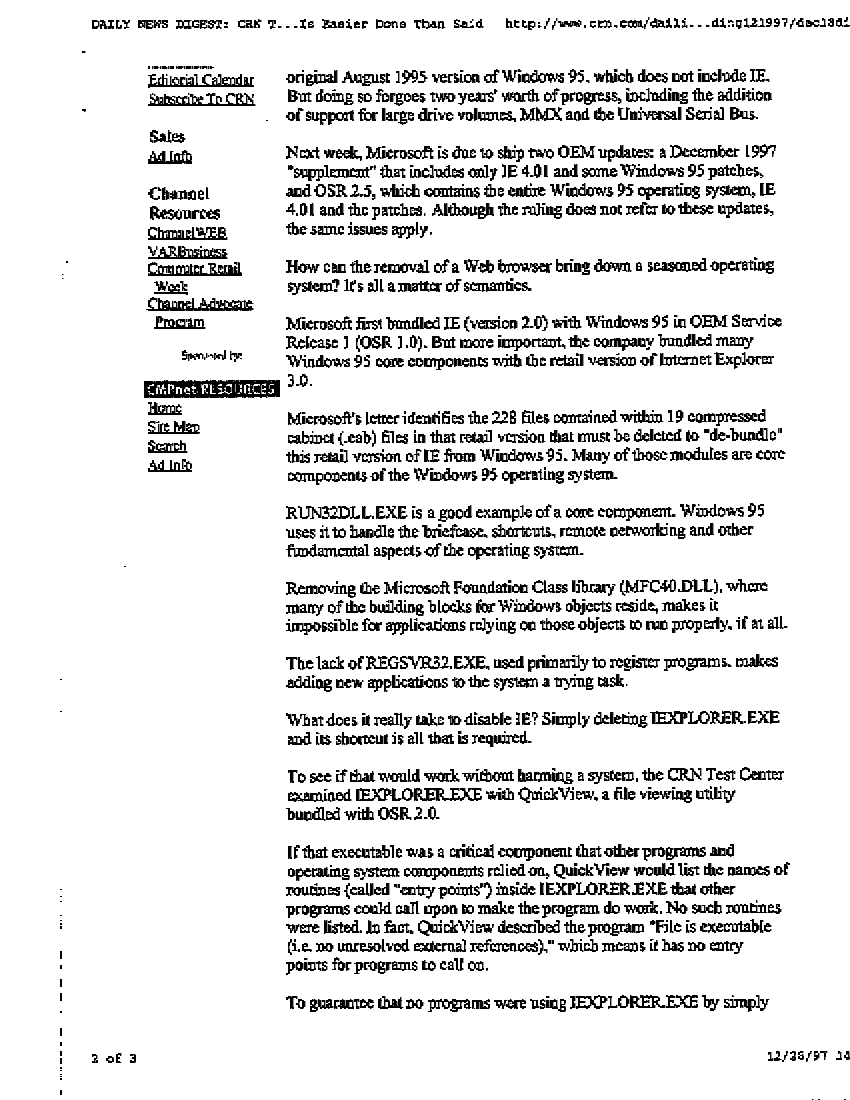
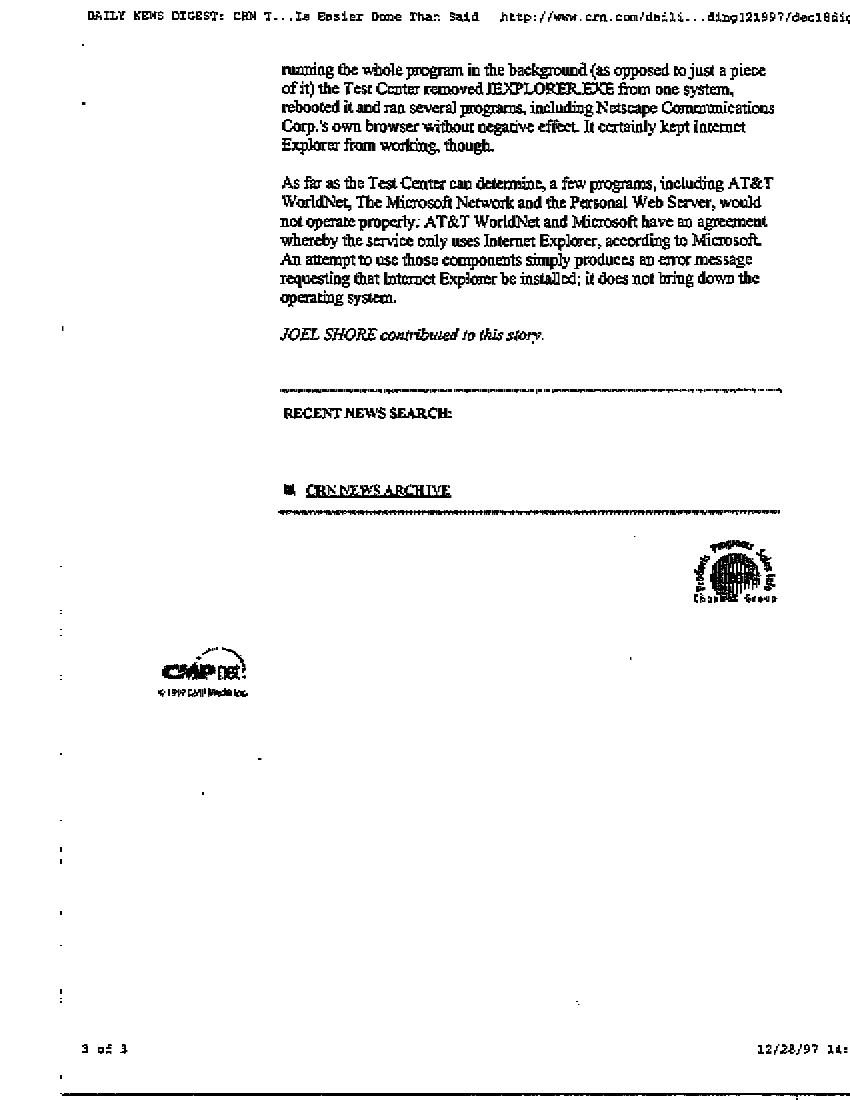
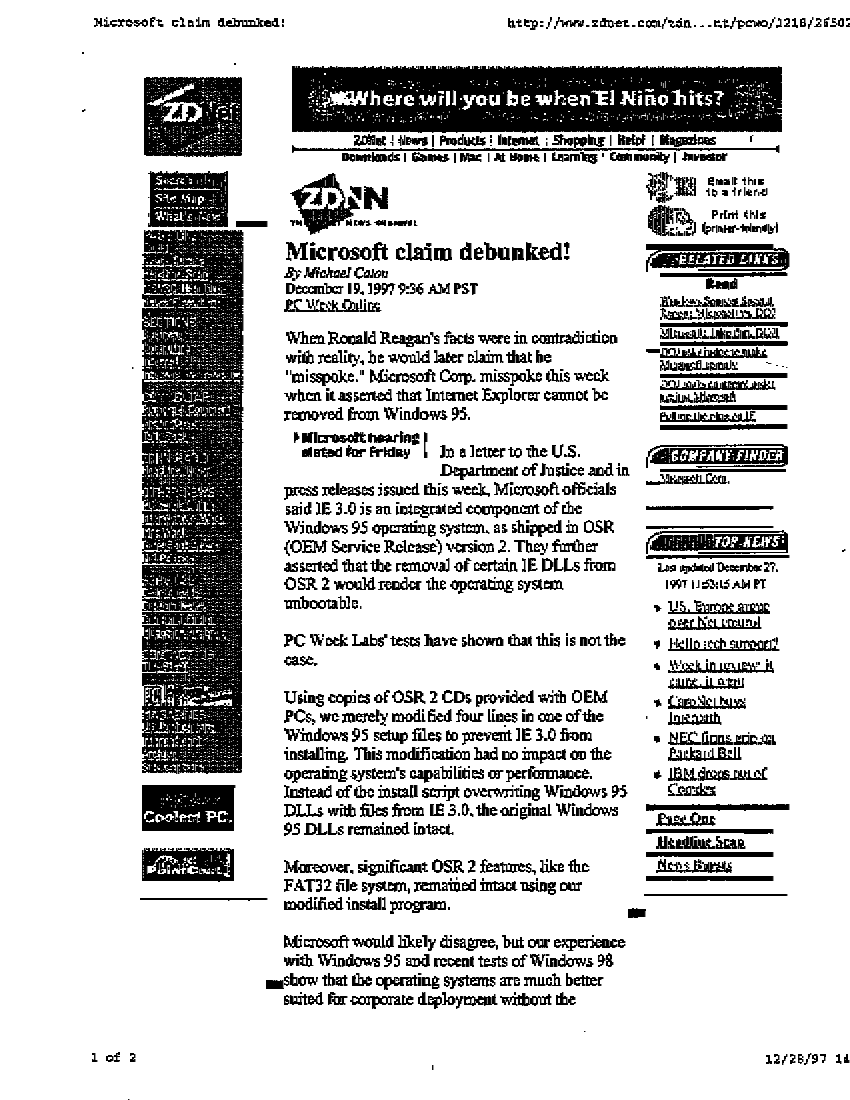
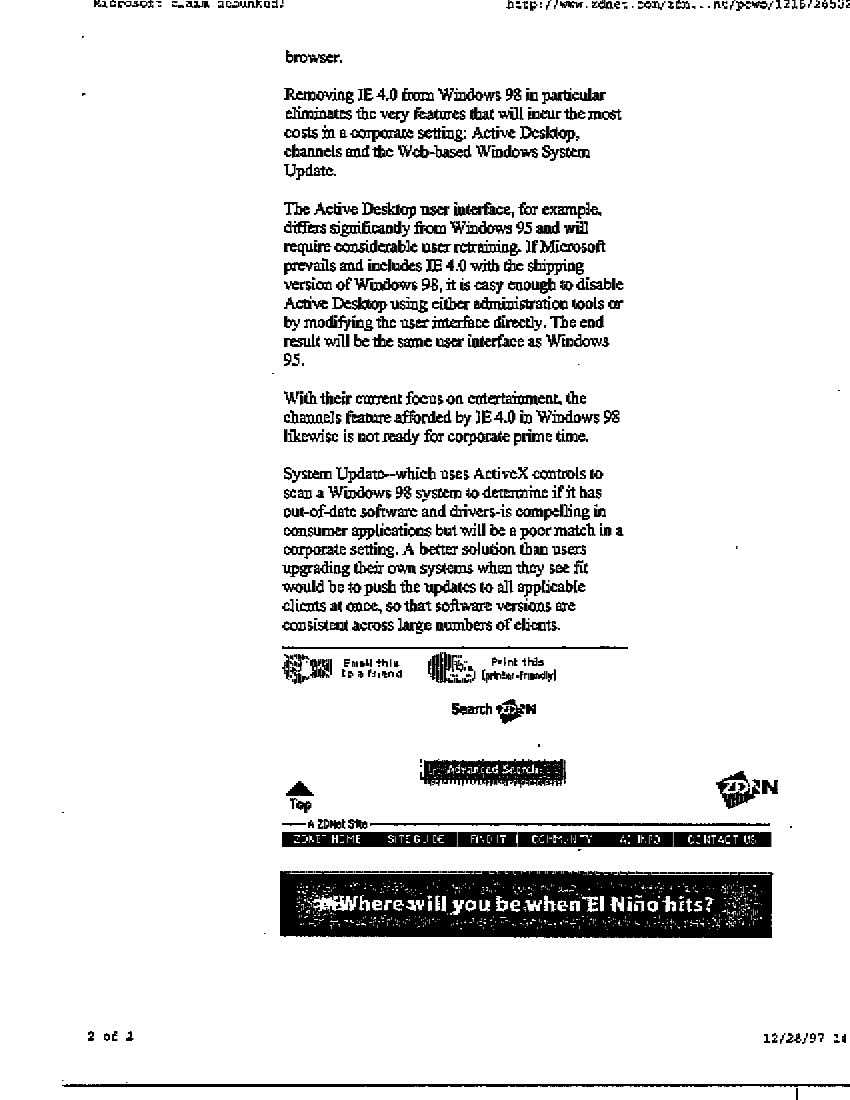
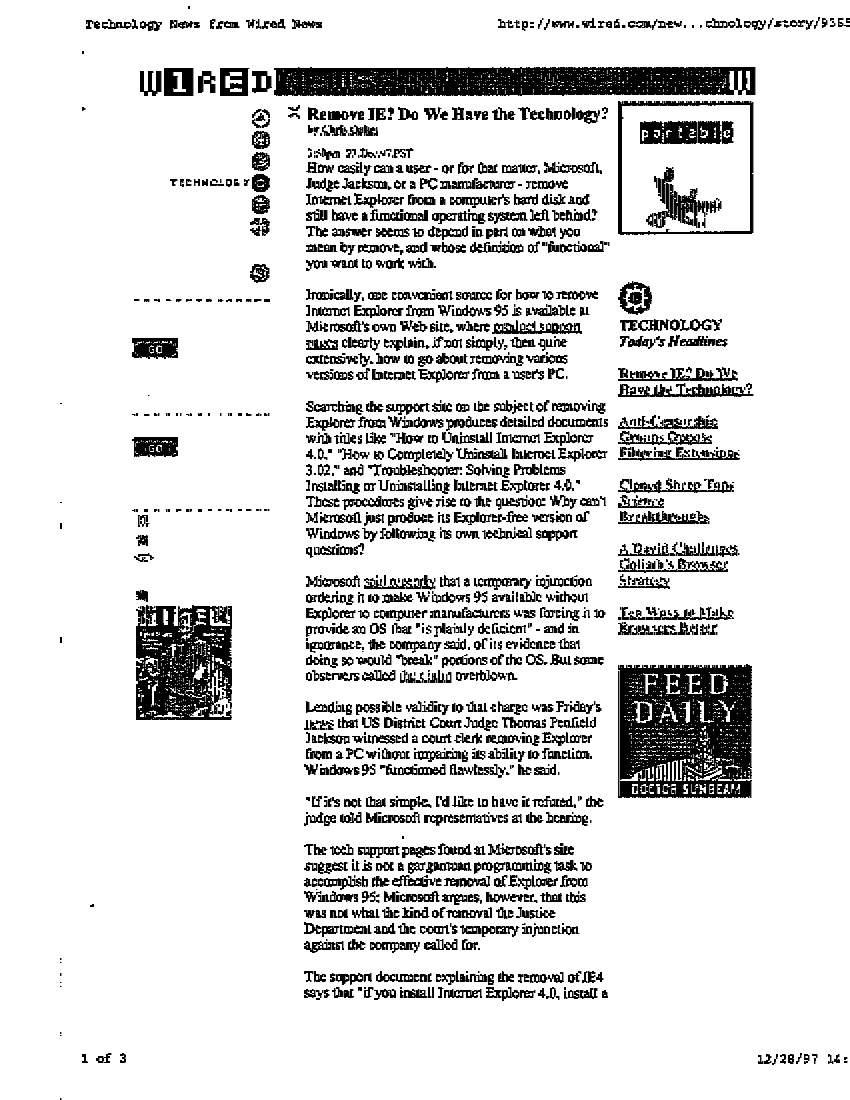
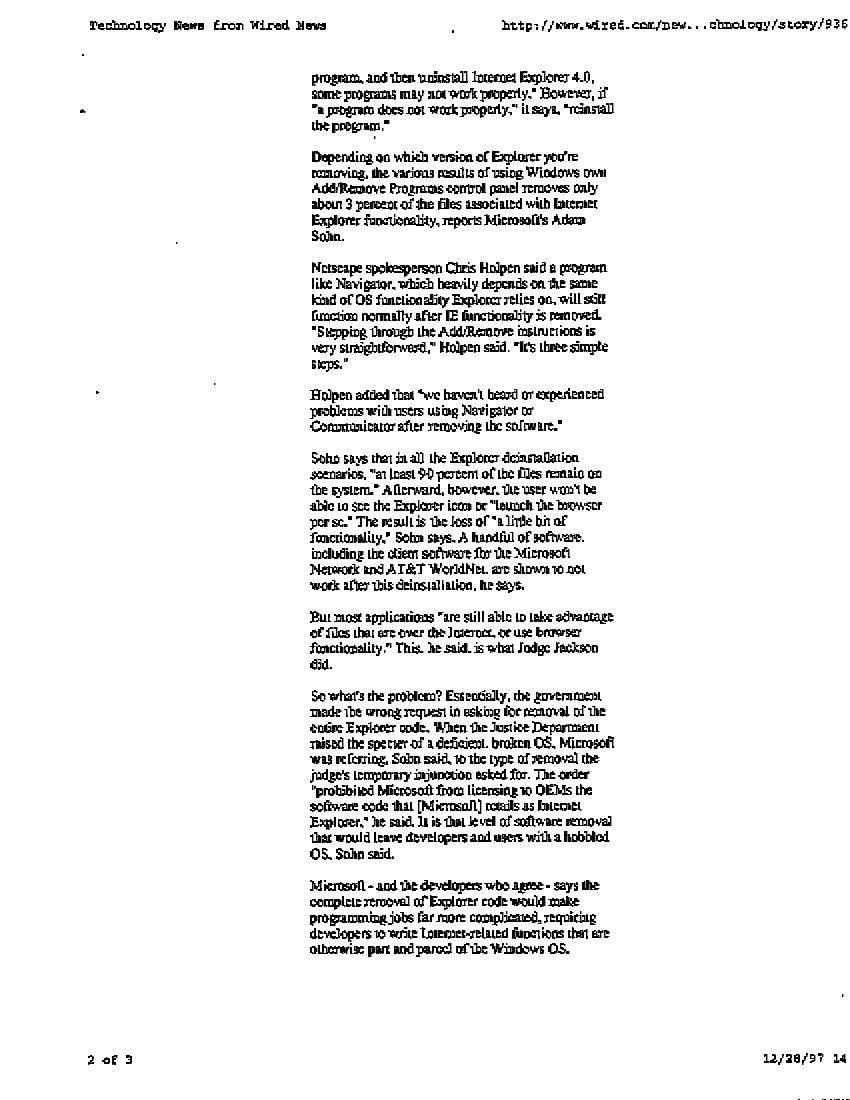
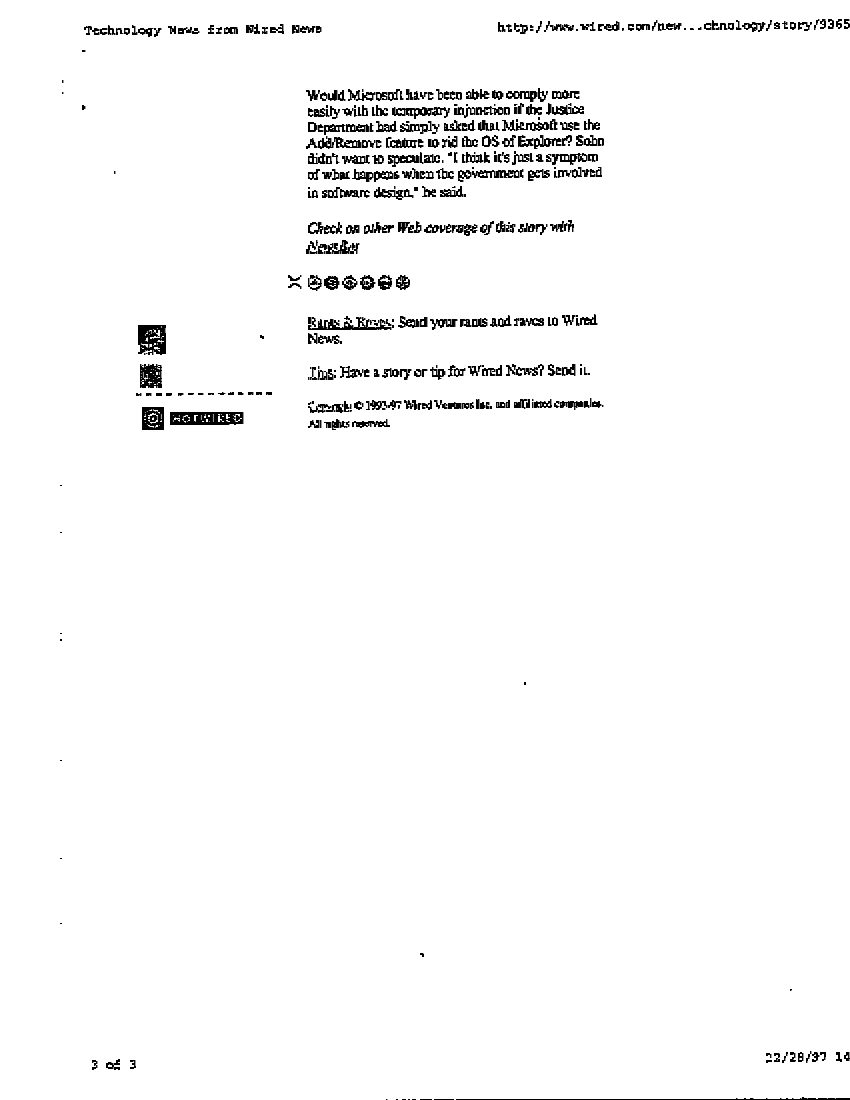

 U.S. Department
of Justice
U.S. Department
of Justice